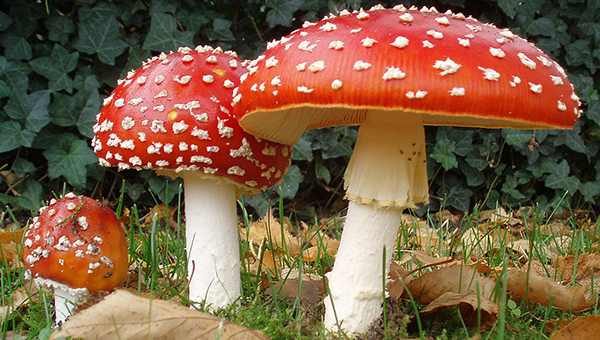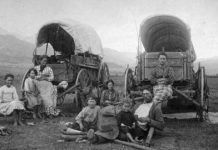The odds are in every SHTF situation that you will have to supplement your diet by foraging for quite a while. Whether you’re driving around the country to hit your refuge for safety, or searching for something to add a bit of variety to the crops you’re growing, food harvested from the field is a huge advantage. Also in happier times, it’s worth taking a look at what’s happening around you – discovering natural food sources that don’t just save you money is easy; they also taste great.
Mushrooms are worth their weight in gold when you’re trying to keep your diet exciting by foraging. They are very nutritious and there are plenty of ways to cook them – sliced and added to stews, grilled or fried; they’re a perfect way to add flavor and variety to them. However, they are very peculiar in that wild varieties taste much better than cultivated ones. Farmed mushrooms are good but the fact is they are very bland compared to wild ones. A couple of fresh-picked wild mushrooms fried with bacon can hardly beat.
There is a problem with mushrooms though. Many species are safe to eat, and some are delicious. Yet there are also others that can cause you to become critically ill and some are lethal. The traditional taste test to classify toxic plants does not work on fungi either because they are not really plants – they are a different class of living thing, neither plant nor animal. The only way to say whether a fungus is a healthy mushroom or a poisonous toadstool is by looking at it, to classify the species. Get it wrong and you may have a serious problem – for certain poisonous fungi there is no cure or antidote.
Identifying the fungi when they’re fresh is best. Mushrooms are growing fast – usually overnight – and don’t last long. These are easily consumed by insects and small animals, sometimes without distinguishing features. Also rain or wind will wash off any valuable hints on which species you are looking at. If you intend on picking wild mushrooms, it’s best to do it right after dawn. And you’re not just going to be able to tell what you’re picking – you’re going to get new mushrooms that haven’t been infested with insects.
Chasing the mushrooms can be very successful. North America includes several thousand animals, many of which are very common. Most of the mushrooms growing in the United States are edible, but many of them do not taste great and some may be fibrous and chewy. There are even more that are too small to warrant gathering. There are a few dozen varieties that concentrate on mushroom hunters, and some of these are rare – they’re coveted for their flavour, but you won’t find enough of them to be a worthwhile source of food.
On the other hand, many other plants are certainly not nutritious, and about 250 are highly poisonous.
The worst of them can require a liver transplant, or even kill. Across the United States thousands of people a year are poisoned by mushrooms and a few die. Just to make matters worse, some of the most poisonous species look very much like edible ones, so understanding exactly what you’re doing is important. There are some wild mushrooms it’s worth searching for to get you going here – and others you need to steer clear of.
Related: This Common Driveway Weed is One of Nature’s Most Powerful Survival Plants
Edible mushrooms
- Common Mushroom
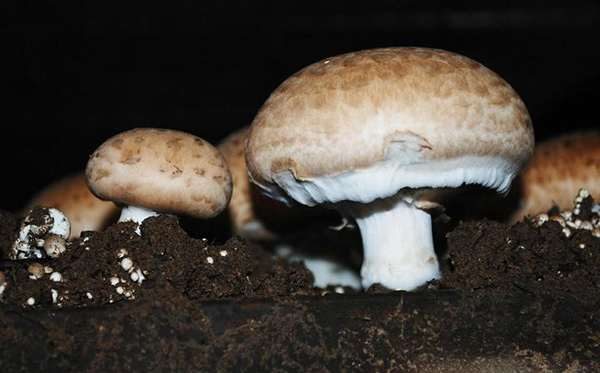

This is a species you’ll definitely be familiar with. It’s Agaricus bisporus for scientists and its English name is the common mushroom but it has a lot more. If you have eaten mushrooms from Portobello they are only big, mature examples of this one. Everything sold as a mushroom of Brown Cap, Cremini, Chestnut, Portabellini or Baby Bella is a smaller, immature mushroom; Swiss, Roman or Italian Brown mushrooms.
Common mushrooms with a cylindrical, thick stem are a light gray-brown color. The gills are pink when immature, but slowly darken through red-brown to a dark brown shade. There is a ring about half way up the stem, sometimes streaked at the edges. The flesh is translucent inside. If the mushroom is small, the cap is a hemisphere but larger ones are more flattened.
Many of the cultivated mushrooms you purchase are common mushrooms. Brown and white are essentially the same species’ color variations and it only appears in young ones – all fully grown specimens are gray.
The common mushroom is typically found on grassland, and sometimes grows in clusters, like many mushrooms the real organism is an underground fibers network, and the visible component is a fruiting body. A large cluster can be an extremely valuable source of food.
- Meadow Mushroom
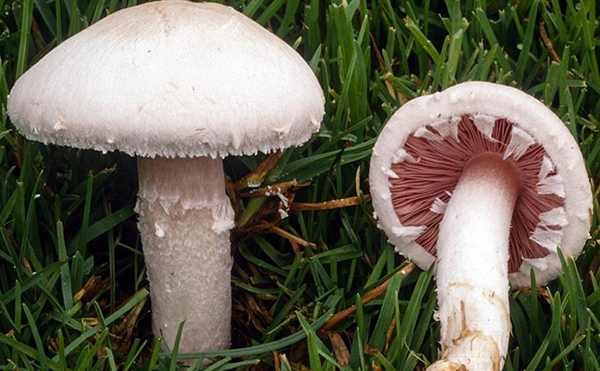

The meadow mushroom, Agaricus campestris, is a close relative of the common mushroom and looks very similar. The main difference is the color – it’s white. In fact, it looks very much like a standard white cultivated mushroom, although it’s a separate species. Like the common mushroom, its gills start off pink, then slowly change to dark brown as it matures.
Again like the common mushroom this species is usually found on grassland, in clusters. If you find what looks like a common or meadow mushroom in a forest be very wary; pay close attention to the color of the gills. If they’re white, don’t eat – or even touch – it.
- Giant Puffball
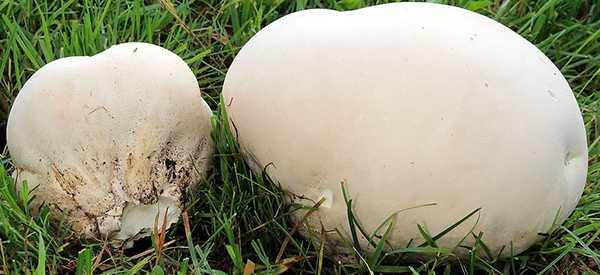

The puffballs are perhaps the most popular of mushrooms. Like most species, they do not have a stalk and gills; they are approximately circular, but sometimes nowhere near a sphere. When a spore chamber matures, it develops internally, and this eventually bursts open and releases up to several trillion tiny spores.
Calvatia gigantea, the giant puffball, is white and sometimes grows to more than two feet in diameter – some monsters exceed five feet and can weigh more than 40 pounds. They need to grow for several weeks, and are best eaten while they are immature. The easiest way to check is to break them in half; it is safe to eat if the meat is white and has no internal structure. Typically, these mushrooms are sliced and fried – they are delicious cooked in butter or bacon fat.
If you cut open something that looks like a little puffball, and you see a stem and gills inside, discard it; it could be a dangerous species.
Puffballs are flexible, and can grow in a number of locations. Most usually they are found in meadows, woods, or deciduous forests.
- Chanterelle
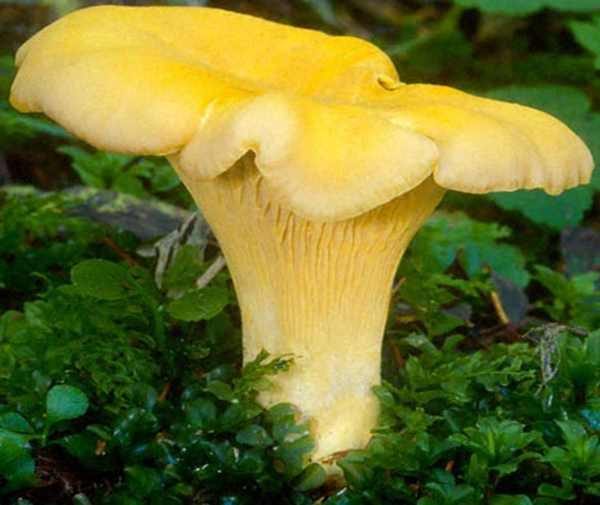

This is another distinctive species. Cantharellus cibarius, best known as the chanterelle, is a relatively common mushroom, and one of the most valued edible ones. This is an excellent source of potassium and vitamins C and D and it is very helpful to add them to your diet.
The chanterelle is a color of yellow or orange and is funnel-shaped, with yellow ridges running down the cap’s exterior. Sometimes the edges of the cap curl inward. Look out for someone with a darker centre; there’s probably the False Chanterelle that isn’t poisonous but doesn’t taste so good and can cause stomach upsets. Real chanterelles have an even color.
Chanterelles thrive in open forest, so look for them in areas where the undergrowth isn’t much. Sometimes they grow in clusters.
- Morel
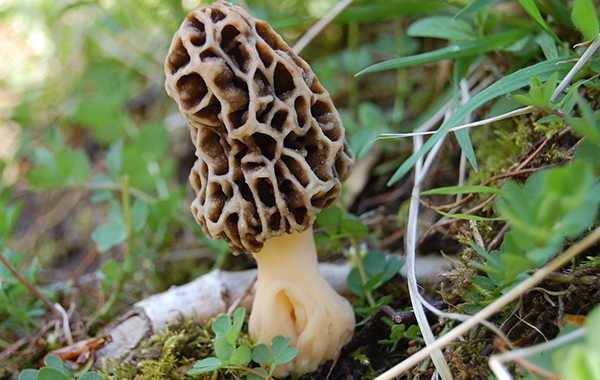

The morel is another mushroom that’s very popular with gourmets. The name gets applied to a genus (Morchella) of closely related species, which also have a wide variety of local names; in West Virginia they’re often called Molly Moochers or Muggins, but Kentucky has come up with the colorful name of Hickory Chicken.
Morels doesn’t look very appetizing. They have a light brown to white cylindrical base, similar to a normal mushroom but the brown cap is very different. It’s tall and thin, and it has a spongy feel – the surface is wrinkled and scratched, so it looks like it has holes. But don’t worry about the appearance – these mushrooms are tasty.
Beware of false morels; they are poisonous, and can cause loss of muscle control in large amounts. These are dangerous, as they can also affect the heart muscle. A false morel’s cap looks more wrinkled, like a brain’s surface, while real morels have the classic look of a honeycomb. If you’re in any doubt cut the stem in half. True morels have a hollow stem, but it’s packed with something that looks like cotton balls, in fake morels.
Morels are woodlands mushrooms, which appear to have strong relations with trees. You are most likely to find them in coniferous forests in the western USA; however, they also thrive under ash, cottonwood, apple trees and dead or dying elms in the east.
Related: Foraging and Using Chokecherry
Non-Edible Mushrooms
- Death Cap
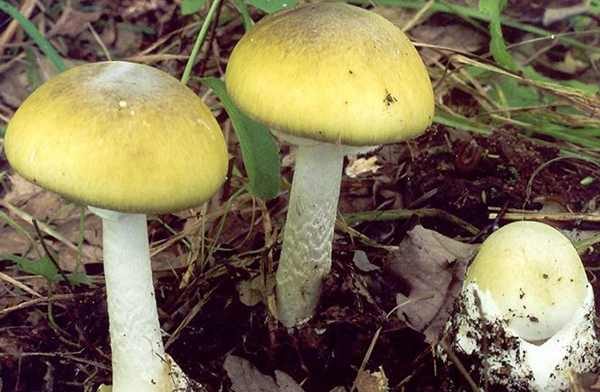

The name of this mushroom should warn you that it’s bad news – and it is. The Death Cap, Amanita phalloides, is one of the most poisonous known fungi; half a mushroom is enough to kill an adult.
The toxins they possess are temperature-stable, so cooking can’t kill them, and if absorbed through the skin, they are harmful too. Once poisoned, treatment is very difficult; the toxin attacks the liver, and a transplant is often needed. Less than half of all fatalities of mushrooms worldwide include death caps; this is a formidable statistic, as it is endemic to Europe alone. Spores are thought to have come to the US in imported chestnut trees and are now also present in Australia, southern Africa and parts of South America.
Those who have consumed death caps claim they have an appetizing taste. That, plus the fact that no signs occur for several days after eating food, also means people consume huge quantities until they become sick. This also looks very much like other edible species like the the Caesar’s and Straw mushrooms.
The death cap has a white stem and a light olive cap with the typical mushroom shape – hemispheric when young, changing to flat and wide as it matures – up to six inches long. Immature ones may be confused with common mushrooms or meadow ones. One way to say is to test the gills-white are the death caps. Another feature of the death cap is the growth of the young mushroom in a white sac called vulva. This appears like a tiny puffball as it first emerges from the ground but as it grows the sac tears open to expose the mushroom. Much of this normally stays near the stem, where the ring on an edible mushroom may imitate it. Certain sections of that also stick to the cap. A relative of the death cap is the white-spotted red toadstool seen in many drawings, and the spots are in fact parts of the vulva.
Death caps are typically found in late summer and fall and in forest. That may help tell them apart from common mushrooms and meadows, which are species of grassland.
Many historical figures are believed to have been killed by death caps, either inadvertently or by murder. Those involve the Holy Roman Emperor Claudius and Charles VI.
- Destroying Angel
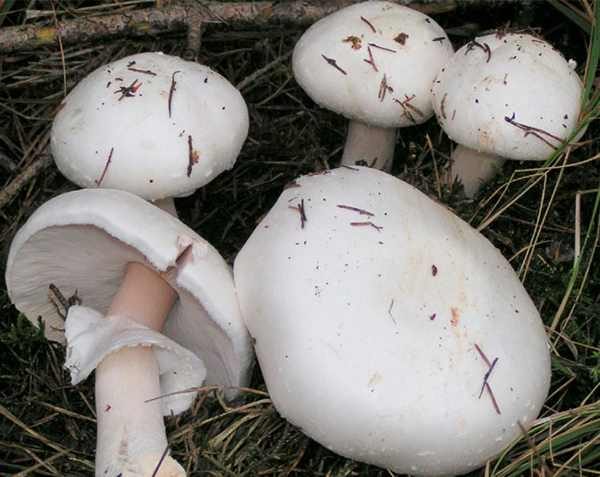

Unlike the death cap and many other of the most dangerous fungi, the numerous Destroying Angel species are members of the Amanita family. Many Amanita species are edible but most mushroom experts suggest avoiding them all on principle-95% of all mushroom victims are killed by the genus. The killing angels are as poisonous as the better known death cap and look very similar to them aside from their color. The primary color is white, rendering them strikingly similar to cultivated mushrooms; a killing young angel looks very much like a mushroom button.
Native to North America, there are at least five species of destroying angel, and their ranges converge to include the whole of the USA. The mushrooms are all medium to huge. They can be more than six inches long, and five inches across the cap when they mature. The stem or cap is often tinged with purple, red, or yellow. Aside from edible animals, the most accurate way to identify them is to check the gills, which are white.
Destroying angels are woodland mushrooms and are generally located on the edge of woods. They can also occur around trees or large bushes on the grass – fungus filaments may run several yards out of the tree’s roots, and the mushrooms emerge from these.
- Fly Agaric
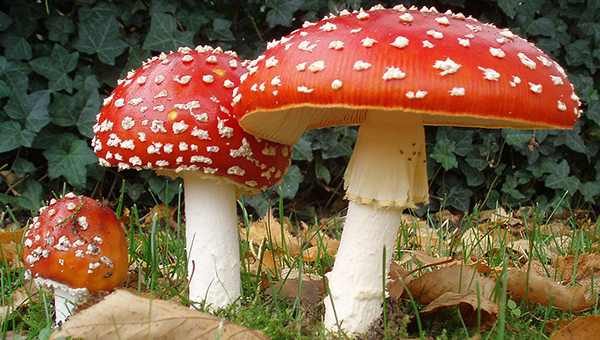

Amanita muscaria is the classic toadstool. A relatively less poisonous member of the Amanita group, it’s sometimes eaten as a hallucinogen – but it’s still dangerous, and it has caused deaths.
Fly agaric is a large mushroom, reaching up to 8 inches long, found in the USA in woodland. It is identifiable immediately, too. The stem is translucent, with the remains of the vulva forming a skirt or false ring. The cap is typically bright red but there are brown variations. It’s covered with tiny white warts; these are fragments of vulva that stuck to the cap when the mushroom emerged from its shell. Heavy rain will wash them away and leave yellowish spots in place.
Some reports claim that parboiling or drying will make fly agaric less toxic but this is not a safe or effective thing to do. This mushroom, even when prepared, can cause severe illness and hallucinations. Avoid that.
- False Parasol
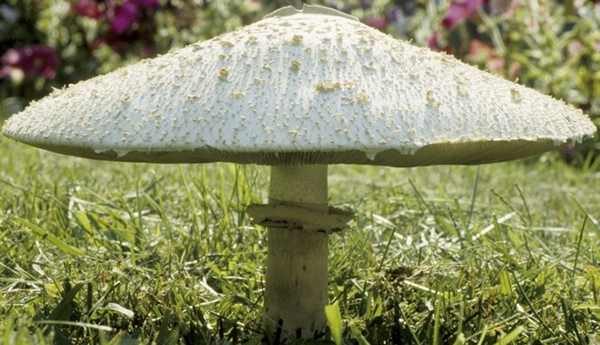

Chlorophyllum molybdites, usually known as the False Parasol, Green-Spored Parasol or Greengills, isn’t as dangerous as the Amanita varieties, but it’s the most commonly eaten poisonous mushroom in North America – and definitely nasty enough to make you wish you’d avoided it.
The fake parasol is a large mushroom that grows to a foot tall and has a diameter of 16 inches. The cap is shaped like a rounded cone, it is whitish in color, and it has brown scales. The stem has a prominent ring and is cylindrical. When immature, the gills are white, and gradually turn dark green with age.
Most of the poisonings from the false parasol occur when people confuse it for a mushroom parasol. The gills are white in a true parasol, often shading to pink; avoid it if you see a green color on the gills. True parasols also have a snakeskin pattern on the cap below the scales; the cap is smooth on the false parasol.
Serious symptoms occur one to three hours after eating the mushroom. Typically can include pain in the stomach, diarrhea and vomiting. There have been no confirmed deaths so far but for a few days it can be bad enough to force you out of action.
- Sulfur Tuft
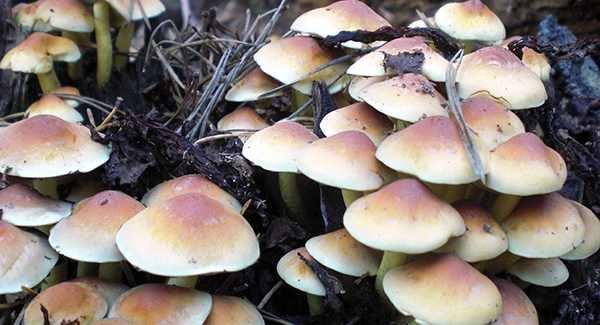

This common mushroom grows in woods, usually around rotting stumps or fallen trees. Sometimes, it’s the only mushroom found that tempts people to try it. The flavor is very bitter and raw, but after cooking, the bitterness vanishes. Sadly the toxicity is not, so eating is still not healthy.
The sulfur tuft, also known as the Clustered Woodlover, may have a diameter of up to five inches and 2.5 inches tall. The stem is light yellow to orange-brown, with a thin ring; in the center, the cap is hemispheric or conical, orange-brown with pale edges. When young, the gills are yellow but darken to green. Normally, this mushroom grows in thick clusters.
Generally, symptoms occur five to ten hours later when ingested, and can be severe. The most severe are diarrhea, nausea and vomiting. Even several victims collapse, or suffer from problems of paralysis and vision. This takes several days for symptoms to clear up. There was one suspected death, as well.
This guide hardly scratches the surface of the mushrooms you might find, but it does cover the most common and useful edible ones – and the ones you really need to avoid. The main rule is to NEVER eat a mushroom you can’t positively identify as being a safe species. If there’s any doubt at all, leave it. After a few days of heavy rain, it can be difficult to tell a young death cap from a young meadow mushroom, and confusion can be lethal. Start by spotting and identifying mushrooms – and do it now, while you have access to the internet to research the ones you find. Take photos and use them to help you work out what species they are. Only start collecting – and even handling – actual mushrooms when you’re 100% sure they’re edible. There are risks in messing around with wild fungi, but if you get it right you’ll have access to a valuable food resource.



